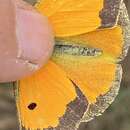en
names in breadcrumbs


The Danube Clouded Yellow occurs in dry, warm grassland where its foodplant, species of the genus Chamaecytisus, are always abundant. However, the amount of shelter from bushes can vary considerably. While the female lays its eggs on the foodplant, the caterpillars hibernate in the litter layer. It has two to three generations a year. The species shows serious declines, especially at the western edge of its range. Within the last years it disappeared most probably from Germany, the Czech Republic, Austria, Hungary, Slovenia and Serbia. Habitats: dry calcareous grasslands and steppes (30%), mesophile grasslands (21%), dry siliceous grasslands (21%), coniferous woodland (8%), mixed woodland (8%).
The species is listed on the Habitats Directive, Annexes 2 and 4. More research is urgently needed on the distribution and ecology of the species. Important habitats should be protected and appropriately managed. The effects of conservation actions should be monitored by a Butterfly Monitoring Scheme. It benefits from proper management of semi-natural grasslands. The species will benefit from the establishment of areas of High Nature Value Farmland. In Hungary the species used to occur only in protected areas. However, there are no recent records from Hungary despite deliberate surveys.
This species is threatened both by intensification and abandonment of semi-natural grasslands, its main habitat. Furthermore, especially for the westernmost parts, climate change is considered as one of the most important reasons for the decline, but it cannot fully explain the situation over this scale. It is certain that in some cases land-use changes even under Agri-Environmental Schemes have led to drastic declines. In general, loss of habitat and habitat connectivity, unfavourable grassland management (wrong timing or intensity) and climate change (less continental climate) must be considered. At this moment abandonment and intensification of grazing and burning are probably the largest threats to the populations in Eastern Europe.
Colias myrmidone, the Danube clouded yellow, is a butterfly in the family Pieridae.
It is found from Western Asia, through Southern Russia, Ukraine, Romania, Hungary up to Austria and the Jura Mountains near Regensburg in Germany.[1]
The wingspan is 44–50 mm. the butterflies of the second generation are often slightly larger than those of the first generation. The wing uppers oft he males are bright orange-yellow in ground colour and have a dark edge that is not dusted. The dark border is narrower on the hind wingsand not broken through by veins (in contrast to Colias crocea ). The wing uppers of the females are orange-yellow to greenish-white ( C. myrmidone f. alba ) in colour and have a dark, dusty border. On the hind wings, the spots of the submarginal region often form a continuous band.In both sexes there is a red spot in the cell on the underside of the hindwing, the underside of the forewing has faint black spots in the postdiscal region [2]
The larvae feed on species of the flowering plant in the genus Chamaecytisus including Chamaecytisus ratisbonensis, Chamaecytisus ruthenicus and Chamaecytisus supinus. Dwarf broom prefers nutrient-poor grassland , as it is quickly overgrown by other plants on fertilized, nutrient-rich soil. But the caterpillars of the butterfly are also dependent on the soil on which their food plants grow being not oversaturated with nutrients. Because if the plants have taken up too much nitrogen from the soil, the caterpillars can not tolerate it and die.
The butterfly flies in May and again from July to August in two generations.[3]
Named in the Classical tradition.In Greek mythology Myrmidone, is one of the Danaïdes, who married and killed Mineus, a son of Aegyptus.